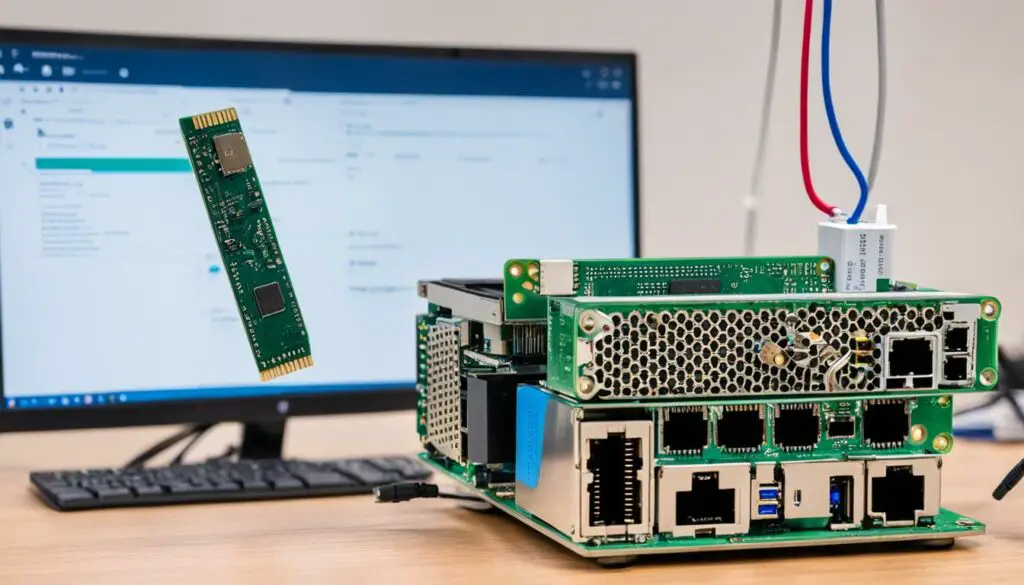Ultimate Guide to Graphical PiZero Stream Deck
Originally posted on January 30, 2024 @ 1:06 pm
We are pleased to present our comprehensive guide to the Graphical PiZero Stream Deck! If you are a content creator seeking a compact and robust stream deck featuring a graphical display, you have come to the ideal resource. This guide will lead you through the steps of configuring a Graphical PiZero Stream Deck to elevate your live streaming experience.
Before we dive into the details, it’s important to note that the PySide2 package is broken in bullseye, which impacts the streamdeck’s connection to the Pi400/Pi4. However, fear not! We’ll guide you through the necessary steps to overcome this challenge and get your stream deck up and running.
The preparation steps for setting up a Graphical PiZero Stream Deck include installing various packages and removing python3-pyside2*. The setup process involves cloning the pyside-setup repository, installing requirements, and compiling the wheels needed for streamdeck-ui. Finally, the deploy step includes installing the compiled wheels and the streamdeck and streamdeck-ui packages. Don’t worry if it sounds complicated; we’ll explain everything in detail.
Now that you have an overview of what to expect, let’s move on to the detailed instructions for setting up your own Graphical PiZero Stream Deck. Get ready to enhance your streaming experience with a versatile and customizable control panel!
Key Takeaways:
- A Graphical PiZero Stream Deck offers a portable and powerful stream deck with a graphical interface for streamers.
- The PySide2 package is broken in bullseye, but we’ll guide you through the necessary steps to overcome this challenge.
- The setup involves installing packages, compiling wheels, and deploying the necessary software.
- Stay tuned for the upcoming sections where we’ll provide detailed instructions for setting up and configuring your own Graphical PiZero Stream Deck.
Setting Up a Graphical PiZero Stream Deck for Live Streaming
Welcome to the second section of our ultimate guide to the Graphical PiZero Stream Deck! In this section, we will discuss how to set up your very own customizable stream deck for live streaming purposes.
We understand that as a streamer, having a powerful and affordable stream deck with graphical features is essential for a seamless streaming experience. That’s where the PiZero Stream Deck comes in. With its compact size and graphical interface, it provides all the control options you need at a fraction of the cost.
Let’s start with the hardware requirements. To create your Graphical PiZero Stream Deck, you will need the following:
- Raspberry Pi Zero 2 W
- HyperPixel 4.0 Square Display
- 3D printed case
Once you have gathered all the necessary hardware, the next step is to set up the software. This involves configuring the Pi Zero, installing dependencies and packages, and designing the UI for your control panel. Here’s a breakdown of the process:
- Attach headers to the Pi Zero to enable connectivity.
- Connect the HyperPixel 4.0 Square Display to the Pi Zero for a high-resolution graphical experience.
- Assemble all the components, including the Pi Zero and display, inside your 3D printed case for a neat and organized setup.
Once you have completed the hardware and software setup, you will have your very own Graphical PiZero Stream Deck ready to enhance your live streaming sessions with a customizable control panel.
It’s worth mentioning that there are alternative ways to create a similar device, but the PiZero Stream Deck offers great affordability and graphical features that make it a popular choice among streamers. With a variety of control options at your fingertips, you can streamline your live streaming workflow and provide an interactive experience for your viewers.

Next, we’ll delve into the details of creating the perfect Pi-hole setup with a Raspberry Pi. Stay tuned for section 3!
Creating the Perfect Pi-hole Setup with a Raspberry Pi
In this section, we will guide you through the process of creating the perfect Pi-hole setup using a Raspberry Pi. Pi-hole is a powerful network-wide ad blocker that can be installed on a Raspberry Pi to enhance security and privacy on your network. Due to recent supply chain issues, acquiring a Raspberry Pi may be challenging, but fear not, we will also explore alternative options such as Docker containers or other operating systems.
To get started, make sure you have the following hardware:
- Raspberry Pi (different versions are available)
- MicroSD card
- Raspberry Pi Imager software
Once you have the necessary hardware, follow these steps to set up your Pi-hole:
- Format the microSD card and use the Raspberry Pi Imager software to write the Raspberry Pi OS Lite. This lightweight version is perfect for running Pi-hole.
- Insert the microSD card into your Raspberry Pi and connect it to your network.
- Find the IP address of your Raspberry Pi, which will be used to access it remotely.
- Use SSH to connect to your Raspberry Pi from your computer.
- Update the packages on your Raspberry Pi to ensure you have the latest software.
- Configure a static IP address for your Raspberry Pi to ensure it remains accessible on your network.
Once you have completed these steps, you are ready to install and configure Pi-hole on your Raspberry Pi. Please refer to the next section for detailed instructions on the installation process.
Before we proceed, we would like to emphasize the importance of supporting the Pi-hole project. It is an open-source initiative that relies on donations for its continued development and support. Donating to the project helps ensure that Pi-hole remains a reliable and effective network-wide ad blocker.

Raspberry Pi Models
| Model | Availability |
|---|---|
| Raspberry Pi Zero | Limited availability |
| Raspberry Pi 3 | Available |
| Raspberry Pi 4 | Available |
Installing Pi-hole and Configuring the Network
In this section, we will guide you through the process of installing Pi-hole on your Raspberry Pi and configuring the network settings. Follow the step-by-step instructions below to get started.
Step 1: Running the Installation Wizard
To install Pi-hole, we need to run a curl command to initiate the installation wizard. Open the terminal on your Raspberry Pi and enter the following command:
curl -sSL https://install.pi-hole.net | bash
Step 2: Completing the Installation Process
Once the installation wizard is running, follow the on-screen instructions to complete the installation process. You may encounter prompts asking for donations, but these are optional.
Note: During the installation process, you might come across a warning regarding the use of a static IP address. If you have already configured a static IP address for your Raspberry Pi, you can proceed without making any changes.
Step 3: Setting a Static IP Address
Now, let’s configure a static IP address to ensure stable network connectivity for your Pi-hole setup. There are two methods you can choose from: DHCP reservation or manual configuration on the Raspberry Pi itself.
- DHCP Reservation: If your router supports DHCP reservation, you can reserve a specific IP address for your Raspberry Pi’s MAC address. Consult your router’s manual or administration interface to configure DHCP reservation.
- Manual Configuration: Alternatively, you can manually set a static IP address on the Raspberry Pi. Here’s how:
Create or modify the dhcpcd.conf file by executing the following command in the terminal:
sudo nano /etc/dhcpcd.conf
Scroll to the end of the file and add the following lines for the desired static IP configuration:
interface eth0
static ip_address=192.168.0.100/24
static routers=192.168.0.1
static domain_name_servers=8.8.8.8 8.8.4.4
Note: Adjust the IP address, subnet mask, router address, and DNS servers according to your network configuration.
Step 4: Reboot and Connect to Pi-hole
Once you have set a static IP address, save the dhcpcd.conf file and reboot your Raspberry Pi to apply the network settings. You can use the following command to reboot:
sudo reboot
After the reboot, reconnect to your Raspberry Pi using SSH, this time with the new static IP address you set.
Summary
Congratulations! You have successfully installed Pi-hole and configured the network settings on your Raspberry Pi. Now your Pi-hole setup is ready to enhance your network’s security and privacy by blocking ads and unwanted content.
| Installation Steps | Status |
|---|---|
| Running the Installation Wizard | Completed |
| Completing the Installation Process | Completed |
| Setting a Static IP Address | Completed |
| Reboot and Connect to Pi-hole | Completed |
Conclusion
In conclusion, the Graphical PiZero Stream Deck offers a powerful and portable solution for streamers looking to enhance their live streaming experience. Despite the challenges of setting up the stream deck, such as the broken PySide2 package in bullseye, the installation process can be time-consuming and requires technical expertise. However, once successfully set up, the graphical interface provides streamers with a customizable control panel to easily manage their streaming activities.
Similarly, creating the perfect Pi-hole setup using a Raspberry Pi can significantly enhance network security and privacy. While the availability of Raspberry Pis may be limited, alternatives such as Docker containers or other operating systems can be used. By following the step-by-step installation and configuration instructions, streamers can effectively block ads across their entire network, ensuring a seamless browsing experience and supporting the Pi-hole project through donations.
Overall, both the Graphical PiZero Stream Deck and the Pi-hole setup demonstrate the versatility and creative possibilities that a Raspberry Pi offers. Whether streamers are looking to improve their live streaming control or enhance their network security, these projects provide valuable solutions. With the proper knowledge and technical skills, streamers can take advantage of these tools to optimize their streaming setups.
FAQ
Can I use the Graphical PiZero Stream Deck for live streaming?
Yes, the Graphical PiZero Stream Deck is designed specifically for live streaming purposes, offering a customizable control panel for streamers.
Is the Graphical PiZero Stream Deck affordable?
Yes, the Graphical PiZero Stream Deck is an affordable option compared to other stream decks available in the market.
What hardware is required for the Graphical PiZero Stream Deck setup?
The hardware required includes a Raspberry Pi Zero 2 W, HyperPixel 4.0 Square Display, and a 3D printed case.
What is Pi-hole and how can I set it up with a Raspberry Pi?
Pi-hole is a network-wide ad blocker that can be installed on a Raspberry Pi to enhance security and privacy on the network. You can follow the step-by-step instructions provided to set it up on a Raspberry Pi.
Are Raspberry Pis readily available for purchase?
Due to supply chain issues, acquiring Raspberry Pis might be challenging at times. However, alternative options such as Docker containers or other operating systems can also be used.
What hardware do I need for setting up Pi-hole?
To set up Pi-hole, you will need a Raspberry Pi (with different versions available), a microSD card, and Raspberry Pi Imager software.
How do I set a static IP address for my Raspberry Pi?
There are different methods for setting a static IP address, either through a DHCP reservation or manually on the Raspberry Pi. The installation guide provides instructions for setting a static IP on the Raspberry Pi using the dhcpcd.conf file.
Why is it important to donate to the Pi-hole project?
Donating to the Pi-hole project is crucial for its continued development and support, ensuring that it remains a powerful network-wide ad-blocking solution.
How can I install Pi-hole on a Raspberry Pi?
You can install Pi-hole on a Raspberry Pi by running a curl command to initiate the installation wizard and following the prompts provided during the installation process.
How can I connect to Pi-hole after setting it up with a static IP address?
Once you have set up Pi-hole with a static IP address, you can connect to it using SSH with the new IP address assigned to the Raspberry Pi.







